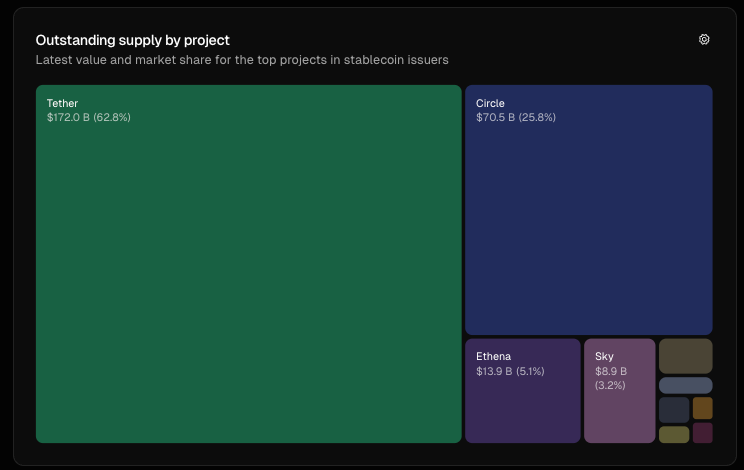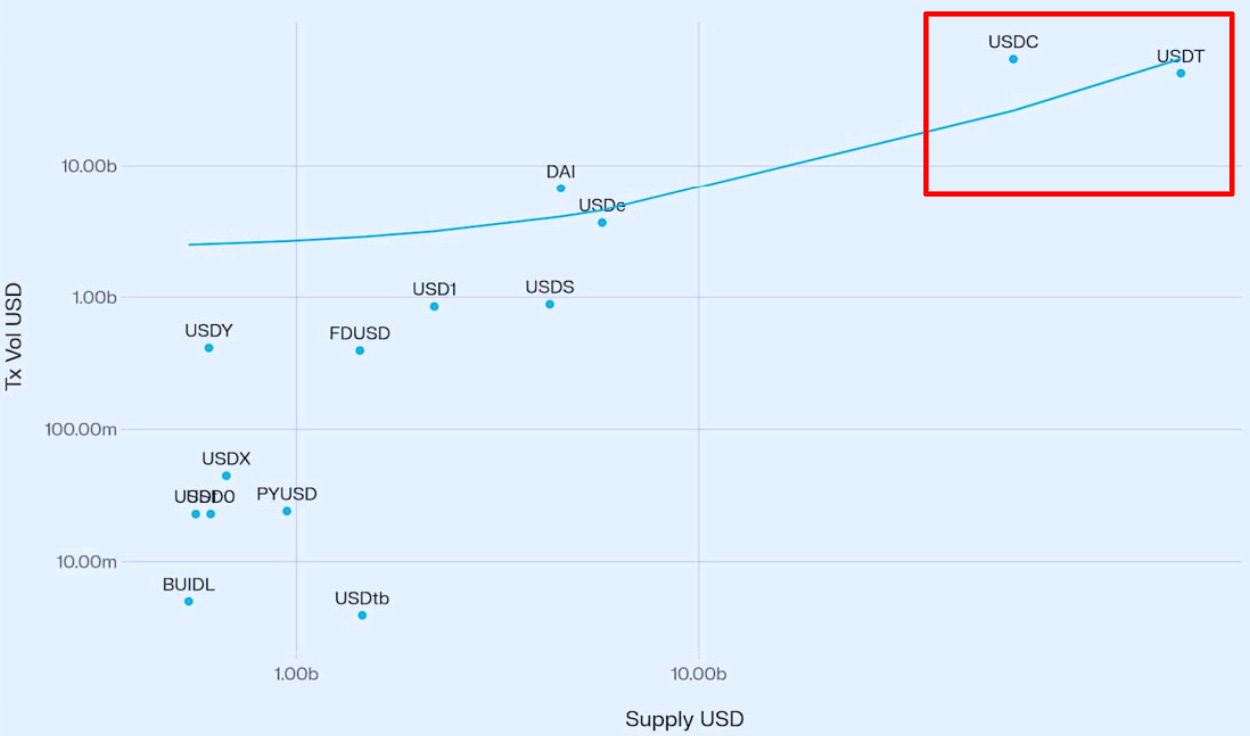What is the Endgame of Stablecoin-Driven Layer 1?
Author: Terry Lee
Translation: Deep Tide TechFlow

Meme depicting Tether, Stripe, and Circle launching their respective versions of L1
Introduction
In less than 12 years, stablecoins have evolved from a niche crypto experiment and are still accelerating in growth as of September 2025. Notably, this growth is driven not only by market demand but also by regulatory clarity—the recently passed GENIUS Act in the U.S. and the EU's MiCA provide support for the legitimacy of stablecoins. Today, stablecoins have been recognized by major Western governments as a crucial cornerstone of future finance. More interestingly, stablecoin issuers are not only "stable" but also highly profitable. Driven by the high-interest rate environment in the U.S., Circle, the issuer of USDC, reported revenues of $658 million in Q2 2025, most of which came from reserve interest. Circle has been profitable since 2023, with a net income of $271 million.

Source: tokenterminal.com, current outstanding supply of stablecoins
This profitability has naturally sparked competition. From Ethena's algorithmic stablecoin USDe to Sky's USDS, challengers are constantly emerging, attempting to break the market dominance of Circle and Tether. As competition intensifies, leading issuers like Circle and Tether are turning to develop their own Layer 1 blockchains, aiming to take control of future financial infrastructure. These financial infrastructures are designed to deepen moats, capture more fees, and potentially reshape the flow of programmable money on the internet.
A trillion-dollar question is: Can giants like Circle and Tether withstand the impact of non-stablecoin-native participants like Tempo?
Why Choose Layer 1? Background and Differentiation Analysis
Layer 1 blockchains serve as the foundational protocol of an ecosystem, responsible for transaction processing, settlement, consensus, and security. For technologists, it can be likened to the operating system in the crypto space (like Ethereum or Solana), upon which all other functionalities are built.
For stablecoin issuers, entering Layer 1 is a strategy of vertical integration. Rather than relying on third-party chains (like Ethereum, Solana, or Tron) or Layer 2 solutions, they are actively building their own infrastructure to capture more value, enhance control, and comply with regulations.
To understand this power struggle, we can look at the common characteristics and unique distinctions of the Layer 1 blockchains of Circle, Tether, and Stripe:
Common Characteristics:
Use their respective stablecoins as native currencies, eliminating the need to hold ETH or SOL to pay gas fees. For example, Circle's Arc fees will be paid in USDC, while other scenarios like Plasma completely waive gas fees.
High throughput and fast settlement: Each Layer 1 promises sub-second finality and thousands of TPS (e.g., Plasma's 1000+ TPS, Stripe's Tempo reaching 100,000+ TPS).
Optional privacy and regulatory environment: These are more privacy-focused and compliant crypto ecosystems, but at the cost of centralization.
EVM compatibility, ensuring familiar development standards for developers.
Unique Distinctions:
Circle's Arc is designed for both retail and institutional users. Its internal forex engine (Malachite) makes it highly attractive in capital markets trading and payments, potentially positioning Arc as the "Wall Street" preferred crypto infrastructure.
Tether's Stable and Plasma focus on accessibility, offering zero transaction fees to facilitate frictionless trading for retail and P2P users.
Stripe's Tempo takes a different approach, adhering to stablecoin neutrality. Since Tempo relies on its internal AMM mechanism to support various USD tokens, it may be highly attractive to developers seeking flexibility and users indifferent to which USD token they use.
Layer 1 Adoption Trends
From my inference, there are three main trends:
Trend 1: Access to Traditional Finance—Trust and Regulation
For stablecoin issuers, building their own Layer 1 is key to gaining trust. By controlling the infrastructure or ecosystem rather than merely relying on Ethereum, Solana, or Tron, Circle and Tether can easily provide compliant infrastructure that aligns with frameworks like the GENIUS Act (U.S.) and MiCA (EU).
Circle has positioned USDC as a regulated product, requiring entities exchanging USDC for USD to comply with "Know Your Customer" (KYC) and Anti-Money Laundering (AML) frameworks. Its newly launched Layer 1 protocol Arc goes further by combining auditable transparency with privacy features, making it a reliable candidate for institutional adoption. Tether has adopted a similar strategy with its Stable and Plasma chains, aiming to become the infrastructure pillar for banks, brokers, and asset management firms.
The potential "ideal" application scenario here is forex trading. Circle's Arc boasts sub-second finality, over 1000 TPS, and forex capabilities. Arc can enable market makers and banks to settle forex trades instantly, creating opportunities for them to enter the daily forex market exceeding $7 trillion and forming strong network effects. Stablecoins like USDC and EURC could become the native settlement assets, locking developers firmly within their ecosystem. This could also open doors for DeFi applications supporting institutional-level Request for Quote (RFQ) systems, leveraging smart contracts to reduce counterparty risk and ensure rapid settlement.

This scenario assumes the use of Chainlink oracles for illustration purposes.
A flowchart illustrating the process of trading through Circle's Layer 1
Imagine a scenario where a forex trader based in Paris can directly execute a $10 million USD to EUR trade on Arc using the USDC/EURC trading pair via Malachite. I assume they can use Chainlink's oracle to obtain real-time exchange rates (e.g., 1 USD = 0.85 EUR) and execute the $10 million USDC to EURC conversion transaction in under 1 second, reducing the traditional forex settlement delay from T+2 to T+0. Done!

Source: Research on Stablecoin Growth and Market Dynamics by Vedang Ratan Vatsa
Research supports this direction. According to Vedang Ratan Vatsa's study, there is a strong positive correlation between stablecoin supply and transaction volume, meaning that a larger supply leads to deeper liquidity and higher adoption rates. As the two major issuers, Tether and Circle are thus well-positioned to capture this institutional liquidity.
However, the integration of traditional finance with blockchain infrastructure still faces significant challenges. Coordinating regulatory bodies, central banks, and regional laws requires navigating a complex environment (e.g., interfacing with various central banks may take years). Issuing stablecoins for different currencies (e.g., designing an XYZ token for emerging market currencies) further complicates matters, as adoption may be slow or even nonexistent in developing economies due to limited product-market fit. Even if these obstacles are overcome, banks and market makers may still be reluctant to migrate critical infrastructure to new chains. This shift could incur additional costs, as not all currencies can be tokenized, forcing institutions to maintain both crypto and traditional systems simultaneously. Moreover, as multiple issuers (like Circle, Tether, Stripe, and potential banks) launch their own blockchains, the risk of liquidity islands is increasing. Fragmentation may prevent any single chain from achieving the scale or liquidity necessary to dominate the daily $7 trillion forex market.
Trend 2: Do Stablecoin Chains Threaten Traditional Payment Infrastructure?
As Layer 1 attracts traditional finance with its programmable features, its rise could also disrupt traditional payment giants like Mastercard, Visa, and PayPal by providing instant, low-cost settlement services across a wide range of decentralized applications. Unlike closed single-platform systems, these platforms are open and programmable, offering developers and fintech companies a flexible foundation, similar to renting AWS cloud infrastructure instead of hosting payment infrastructure. This shift could enable developers to deploy cross-border remittances, agent (AI-driven) payments, and tokenized asset products while enjoying near-zero fees and sub-second finality.
For example, developers could build a payment dApp on a stablecoin chain to achieve instant settlement. Merchants and consumers would benefit from fast, low-cost transactions, while Layer 1s like Circle, Tether, and Tempo capture value as indispensable infrastructure. The key difference from traditional systems is that these systems eliminate intermediaries like Visa and Mastercard, directly creating more value for developers and users.
However, risks are everywhere. As more issuers and payment companies launch their own Layer 1s, the ecosystem faces the risk of fragmentation. Merchants may encounter a chaotic situation with different chains offering "USD" that cannot be easily exchanged. Circle's Cross-Chain Transfer Protocol (CCTP) attempts to address this issue by creating a single liquid version of USDC across multiple chains, but its coverage is limited to Circle's token. In an oligopolistic market, interoperability may become a critical bottleneck.
The landscape has further changed with Stripe's recent announcement of Tempo. Tempo is a stablecoin-neutral Layer 1 platform co-incubated with Paradigm. Unlike Circle and Tether, Stripe has not launched its own token; instead, it supports multiple stablecoins for gas and payments through a built-in AMM. This neutrality may attract developers and merchants seeking flexibility without being locked in, potentially allowing Stripe to carve out a niche in a space long dominated by cryptocurrency-native companies.
Trend 3: Duopoly Dynamics—Circle vs. Tether
As these Layer 1s challenge traditional players, they are also reshaping the market structure. Currently, Circle and Tether dominate the stablecoin space with nearly 89% of the issuance, with Tether accounting for 62.8% and Circle for 25.8% as of September 2025. By launching their own Layer 1s (Arc and Stable/Plasma), they consolidate their dominance by setting high entry barriers. For example, Plasma raised $1 billion in deposits for its token sale cap, creating a significant entry barrier.
However, a subtle threat emerges in the form of stablecoin-neutral Layer 1s. Stripe's Tempo reduces the access friction for merchants and the concentration risk for regulators. If neutrality becomes the standard, the closed moats of Circle and Tether may turn into weaknesses. Should neutrality become the norm, Circle and Tether could lose network effects and market share. The current duopoly may shift towards an oligopoly, with multiple chains competing for market share.
Conclusion
In summary, as stablecoins have now become a powerful asset class exceeding $280 billion, issuers are reaping significant rewards, and the rise of stablecoin-supported Layer 1s reveals three important trends:
(1) Accessing traditional finance through crypto-native infrastructure, entering the growing forex market;
(2) Transforming payments by eliminating intermediaries like Mastercard and Visa;
(3) Redefining the market structure from a duopoly to an oligopoly.
These shifts collectively point to a grander vision: stablecoin issuers like Circle and Tether, along with new entrants like Stripe's Tempo, are positioning themselves not just as bridges between cryptocurrencies and fiat currencies, but as cornerstones of future financial infrastructure.
Ultimately, this raises a question for my readers: How will these chains achieve product-market fit? Will it be Circle's Arc, Tether's Stable/Plasma, or stablecoin-neutral challengers like Tempo that lead in transaction volume or institutional adoption? Despite the opportunities and liquidity fragmentation, obstacles remain. I welcome readers to share your thoughts!
免责声明:本文章仅代表作者个人观点,不代表本平台的立场和观点。本文章仅供信息分享,不构成对任何人的任何投资建议。用户与作者之间的任何争议,与本平台无关。如网页中刊载的文章或图片涉及侵权,请提供相关的权利证明和身份证明发送邮件到support@aicoin.com,本平台相关工作人员将会进行核查。




